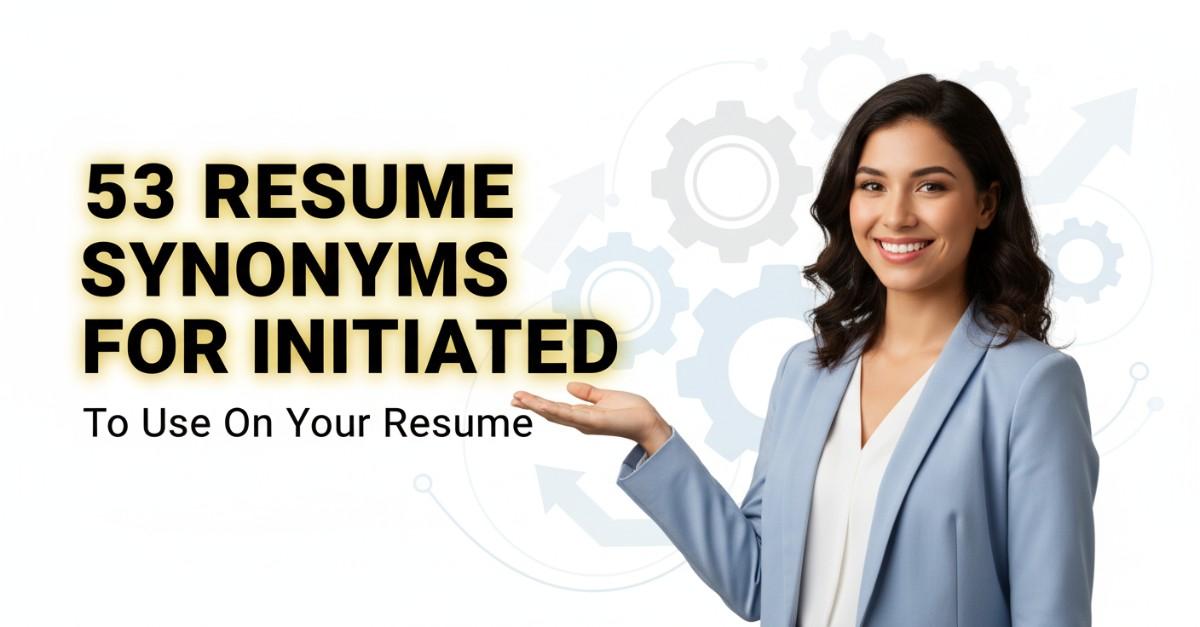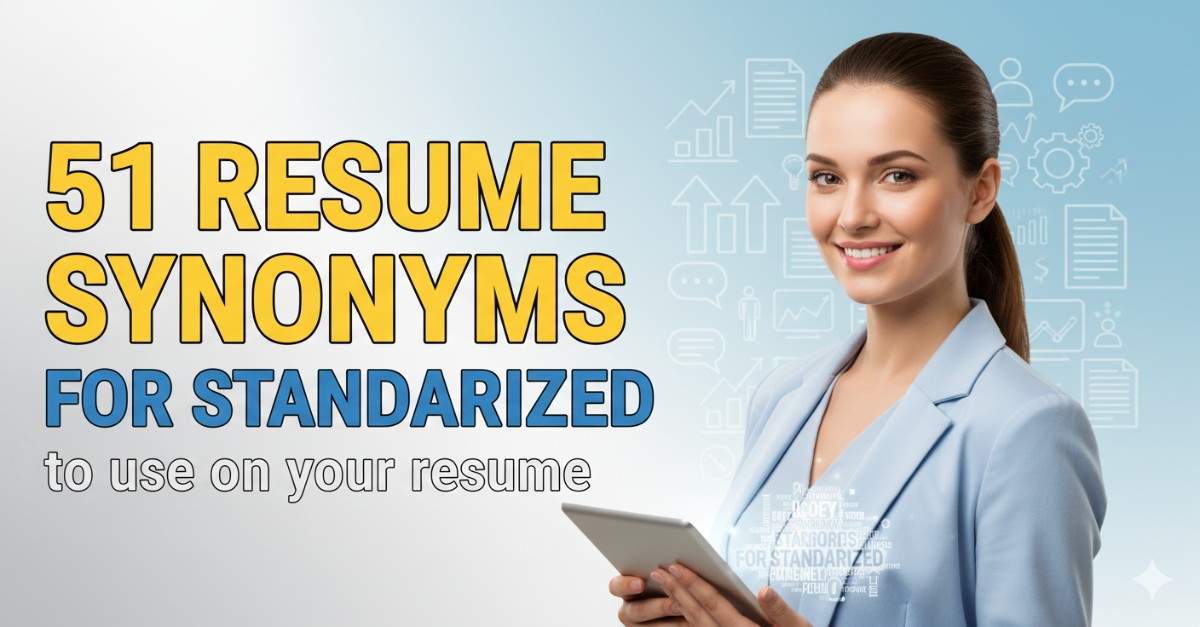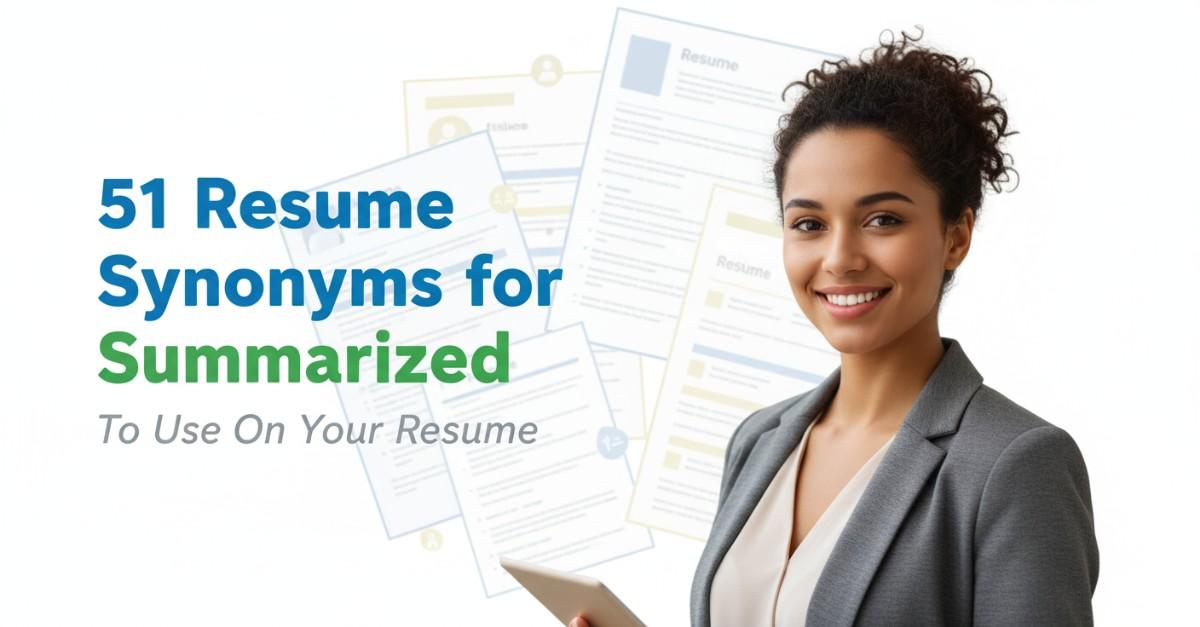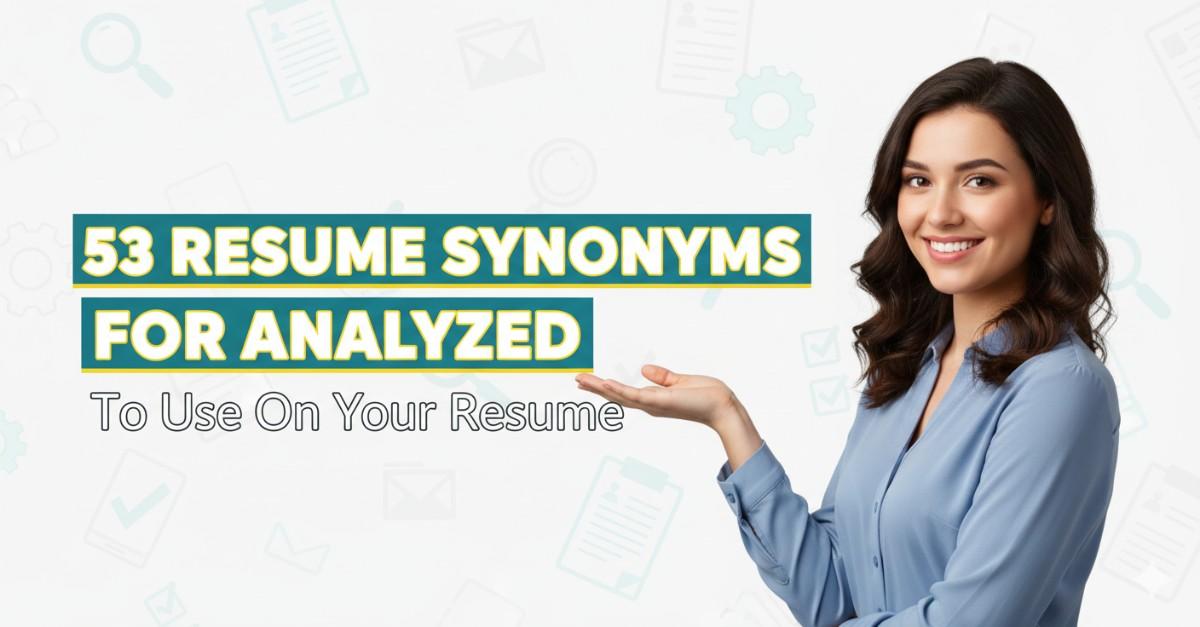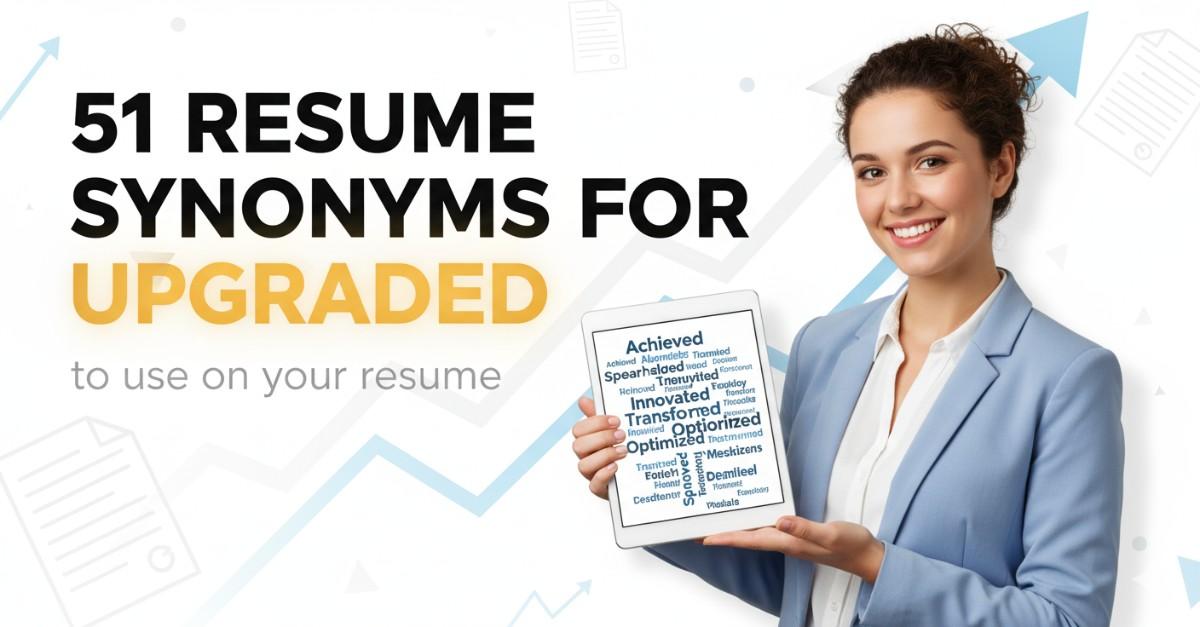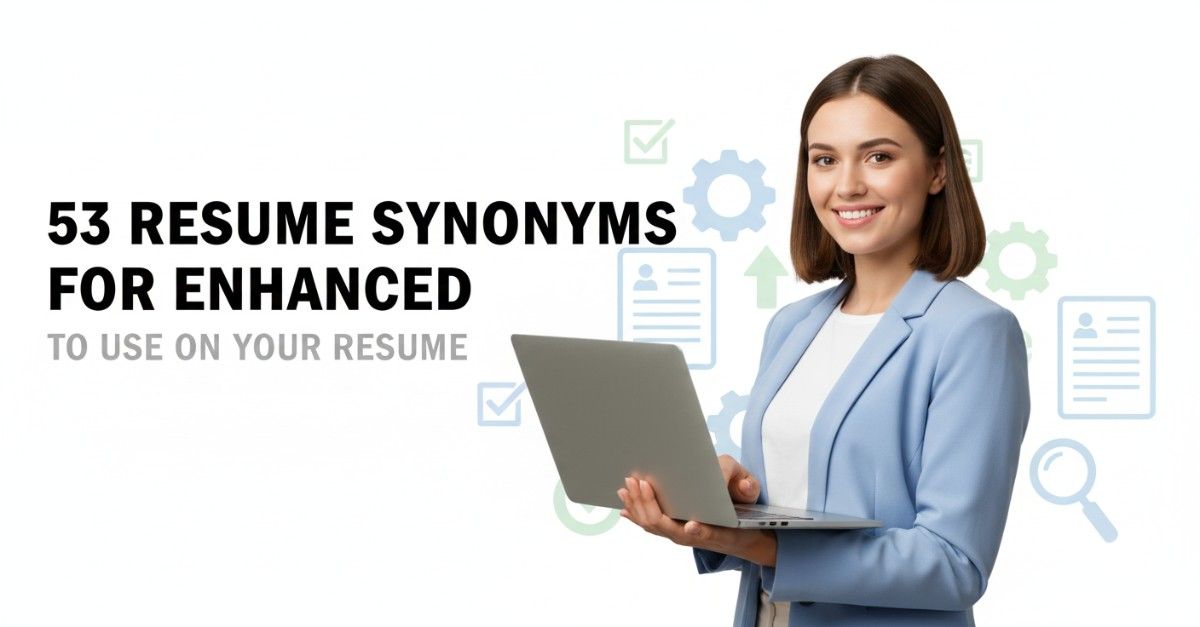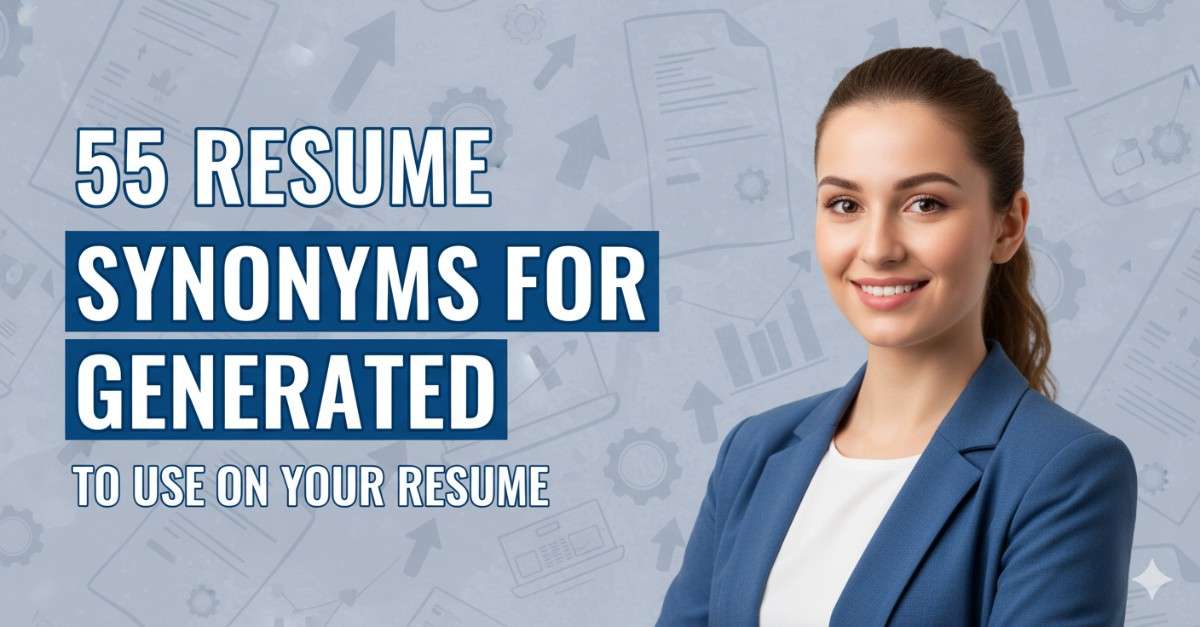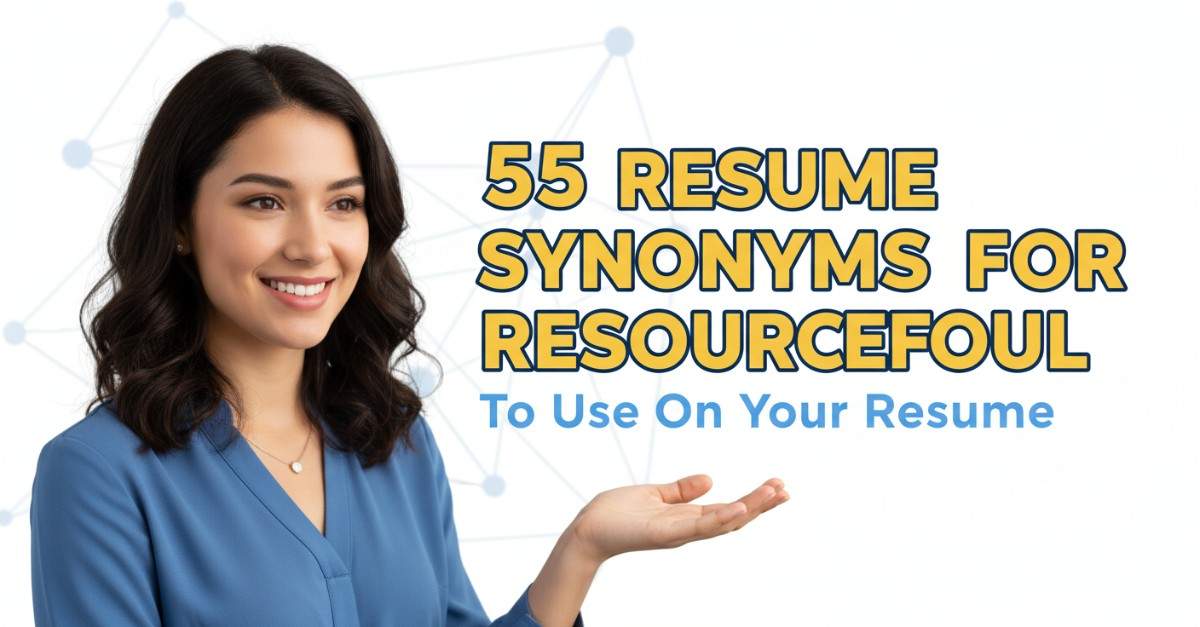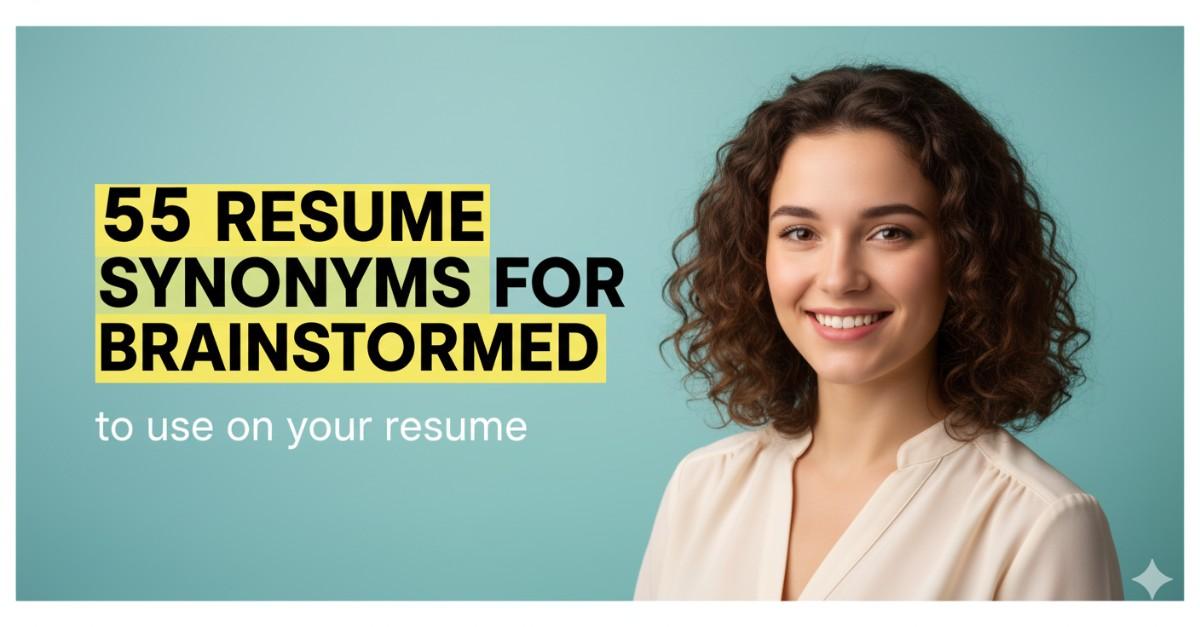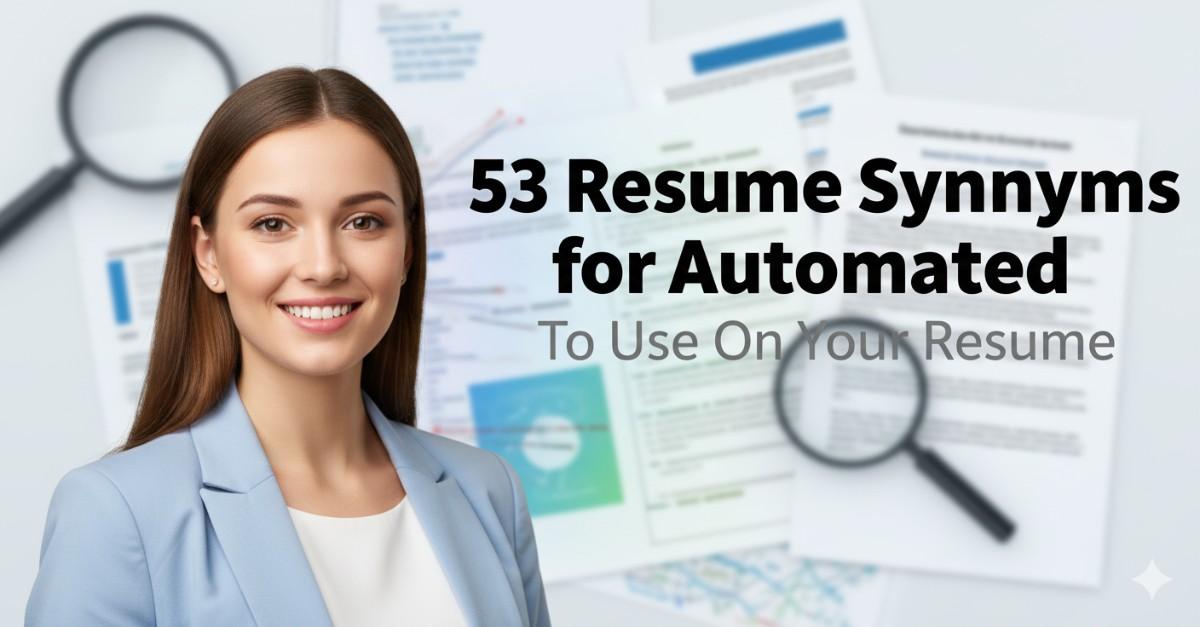
53 Resume Synonyms for Automated To Use On Your Resume
In today’s competitive job market, the word “automated” frequently appears on resumes, often to describe processes, tasks, or systems that have been streamlined through technology. While the term accurately conveys efficiency, its overuse can dilute its impact, making candidates blend in rather than stand out. Relying heavily on a single descriptor suggests a lack of creativity and fails to highlight the nuanced skills that hiring managers seek. Varied vocabulary not only enhances readability but also demonstrates a rich understanding of the role and industry, allowing candidates to articulate their experiences more effectively. This comprehensive guide will delve into the importance of synonyms in resume writing, providing strategies to diversify language, examples of effective alternatives to “automated,” and tips on how to convey similar meanings without repeating phrases. By embracing a broader vocabulary, candidates can better showcase their expertise and unique contributions, making a compelling case to potential employers.
- Why Synonyms for “Automated” Matter on Your Resume
- The Complete List: 53 Resume Synonyms for Automated
- Strategic Synonym Selection by Industry
- Power Combinations: Advanced Synonym Usage
- Common Mistakes to Avoid
- Quantification Strategies for Maximum Impact
- Industry-Specific Example Sentences
- Advanced ATS Optimization Techniques
- Tailoring Synonyms to Career Level
- The Psychology of Leadership Language
- Final Best Practices
- Key Takeaways for Strategic Synonym Usage
- Frequently Asked Questions
- How many different synonyms should I use in one resume?
- Can I use the same synonym multiple times if it fits different contexts?
- Should I always replace ‘Automated’ with a synonym?
- How do I know which synonym is most appropriate for my industry?
- Do synonyms really make a difference in getting interviews?
- Related Resume Synonym Guides
Why Synonyms for “Automated” Matter on Your Resume
Using synonyms for the term “automated” on resumes is crucial for several reasons. Firstly, overusing “automated” can lead to monotony and predictability, making your resume less engaging for hiring managers. When this term appears on approximately 70% of professional resumes, it risks blending your qualifications into a sea of sameness, causing missed specificity in your achievements. By incorporating varied terminology, you enhance the impact of your statements, allowing you to articulate distinct contributions more effectively. Moreover, employing synonyms can improve ATS optimization, ensuring your resume ranks higher in applicant tracking systems that may be programmed to recognize diverse vocabulary. Finally, using different words helps create dynamic narratives about your skills and experiences, making your resume more memorable and compelling to potential employers. This strategic choice can differentiate you in a competitive job market, showcasing your attention to detail and creativity.
The Complete List: 53 Resume Synonyms for Automated
Here’s our comprehensive collection of “Automated” alternatives, organized for easy reference:
| Synonym | Best Context | Professional Level |
|---|---|---|
| Streamlined | Process improvement | Mid-level |
| Enhanced | Performance optimization | Mid-level |
| Facilitated | Project management | Entry-level |
| Implemented | Operational efficiency | Mid-level |
| Optimized | Resource management | Senior |
| Digitized | Technology integration | Mid-level |
| Systematized | Workflow management | Senior |
| Integrated | Cross-functional collaboration | Senior |
| Accelerated | Time management | Mid-level |
| Programmed | Software development | Senior |
| Configured | Technical setup | Mid-level |
| Refined | Quality assurance | Senior |
| Modernized | Technological upgrades | Senior |
| Automated | Process automation | Mid-level |
| Simplified | Complexity reduction | Entry-level |
| Executed | Strategic initiatives | Mid-level |
| Standardized | Policy enforcement | Senior |
| Orchestrated | Event coordination | Senior |
| Streamlined | Operational workflows | Mid-level |
| Centralized | Data management | Senior |
| Automated | Data processing | Mid-level |
| Improved | Efficiency metrics | Entry-level |
| Transformed | Business processes | Senior |
| Facilitated | Team collaboration | Entry-level |
| Enhanced | User experience | Mid-level |
| Developed | Software solutions | Senior |
| Executed | Process improvements | Mid-level |
| Consolidated | Resources allocation | Senior |
| Revolutionized | Industry practices | Executive |
| Boosted | Productivity | Mid-level |
| Facilitated | Knowledge transfer | Entry-level |
| Activated | Systems integration | Mid-level |
| Revamped | Outdated processes | Senior |
| Advanced | Technological initiatives | Senior |
| Optimized | Performance metrics | Senior |
| Revitalized | Company strategies | Executive |
| Updated | System protocols | Mid-level |
| Reengineered | Business models | Senior |
| Enhanced | Service delivery | Mid-level |
| Programmed | Automated solutions | Senior |
| Configured | Application settings | Mid-level |
| Streamlined | Customer service processes | Mid-level |
| Refined | Protocols and procedures | Senior |
| Executed | Operational strategies | Mid-level |
| Standardized | Quality assurance processes | Senior |
| Elevated | Operational standards | Mid-level |
| Automated | Reporting systems | Mid-level |
| Activated | Project workflows | Mid-level |
| Enhanced | Technical processes | Mid-level |
| Orchestrated | Team initiatives | Senior |
| Integrated | Systems operations | Senior |
| Elevated | Performance outcomes | Mid-level |
| Facilitated | Process enhancements | Entry-level |
Strategic Synonym Selection by Industry
- Technology:
Technology companies value innovation and systematic thinking. Preferred synonyms include:
- Agile: Reflects the ability to adapt quickly to changes, crucial in tech environments.
- Disruptive: Highlights the potential to transform markets and challenge norms.
- Scalable: Indicates a product or solution that can grow efficiently with demand.
- Healthcare:
Healthcare emphasizes precision and collaborative care. Preferred synonyms include:
- Patient-Centered: Focuses on prioritizing patient needs and experiences.
- Evidence-Based: Highlights the reliance on research and data in decision-making.
- Interdisciplinary: Reflects the importance of teamwork across various specialties.
- Finance:
Finance thrives on accuracy and analytical skills. Preferred synonyms include:
- Risk Assessment: Essential for evaluating potential financial risks and opportunities.
- Portfolio Management: Indicates expertise in managing investments effectively.
- Regulatory Compliance: Highlights adherence to laws and regulations in financial practices.
- Consulting:
Consulting values strategic insight and problem-solving. Preferred synonyms include:
- Stakeholder Engagement: Reflects the importance of involving all parties in the decision-making process.
- Strategic Planning: Highlights the ability to create long-term objectives and actionable steps.
- Change Management: Indicates expertise in guiding organizations through transitions.
- Manufacturing:
Manufacturing focuses on efficiency and quality control. Preferred synonyms include:
- Lean Manufacturing: Emphasizes reduction of waste and optimization of processes.
- Quality Assurance: Indicates a commitment to maintaining high standards in production.
- Supply Chain Management: Reflects the importance of optimizing the flow of goods and materials.
Build your resume in just 5 minutes with AI.

Power Combinations: Advanced Synonym Usage
Advanced synonym usage can enhance your resume by showcasing your skills and experiences more dynamically. By employing power combinations of synonyms, you can create a compelling narrative that resonates with employers.
- In place of “led,” consider using “spearheaded,” which implies initiative and leadership. For example, “Spearheaded a team of 10 in a project that increased sales by 30%.”
- Instead of “managed,” use “orchestrated” to convey a sense of coordination and strategic oversight, like “Orchestrated cross-departmental initiatives that streamlined operations.”
- When moving from marketing to data analytics, replace “analyzed” with “quantified” to emphasize your analytical skills, e.g., “Quantified consumer trends to inform strategic decision-making.”
- Use “cultivated” instead of “developed” when discussing relationship building, such as “Cultivated key partnerships that enhanced brand visibility.”
- For a sales role, use “converted” when discussing clients, like “Converted leads into loyal customers, boosting retention rates by 15%.”
- In a technical context, “engineered” can replace “created,” as in “Engineered a software solution that reduced processing time by 50%.”
Common Mistakes to Avoid
When using synonyms for “automated,” it’s crucial to avoid common mistakes that can undermine your resume’s effectiveness.
Oversaw an automatic system that revolutionized the workflow.
Managed automated processes that improved workflow efficiency by 30%.
Implemented mechanized solutions for data entry.
Executed automated data entry systems that reduced errors by 25%.
Automated customer responses and automated inventory tracking.
Streamlined customer responses through automation and enhanced inventory tracking systems.
Quantification Strategies for Maximum Impact
- Team-Focused Synonyms: When using terms like “led,” “managed,” or “coordinated,” it’s crucial to include quantifiable results. For example, instead of saying “led a team,” specify “led a team of 10 over a 6-month period, resulting in a 30% increase in productivity.” This enhances the impact of the leadership role by providing context and outcomes.
- Project-Focused Synonyms: While using terms such as “oversaw,” “directed,” or “executed,” attach metrics that highlight project success. For instance, instead of stating “oversaw a project,” say “oversaw a $500,000 project completed 2 weeks ahead of schedule, achieving a 15% reduction in costs.” This showcases not only your leadership role but also the tangible benefits of your efforts.
- Strategic-Focused Synonyms: When incorporating words like “strategized,” “developed,” or “initiated,” include before-and-after metrics to illustrate the impact. For example, instead of saying “developed a strategy,” you could say “developed a marketing strategy that increased web traffic from 5,000 to 15,000 monthly visitors within 3 months, enhancing lead generation by 40%.” This clearly demonstrates the effectiveness of your strategic initiatives.
Industry-Specific Example Sentences
- Implemented a systematized process that reduced software deployment time by 40%, significantly enhancing the efficiency of our development team.
- Developed an automated testing framework that increased code coverage from 60% to 90%, resulting in a 30% decrease in post-release defects.
- Designed a streamlined data processing pipeline that handled 500,000 transactions per day, improving data retrieval times by 50%.
- Utilized mechanized solutions to optimize server monitoring, leading to a 25% reduction in downtime and improved user satisfaction ratings.
- Introduced a mechanized patient scheduling system that improved appointment adherence rates by 30%, enhancing overall clinic efficiency.
- Developed an automated medication dispensing system that decreased medication errors by 20%, contributing to improved patient safety.
- Implemented a systematized patient follow-up protocol that increased patient engagement by 40%, leading to better health outcomes.
- Created a streamlined electronic health record system that reduced patient data retrieval time by 50%, improving workflow for healthcare providers.
- Established an automated invoicing system that reduced billing discrepancies by 35%, resulting in improved cash flow for the company.
- Implemented a systematized financial reporting tool that decreased report preparation time from two weeks to three days, enhancing decision-making speed.
- Developed a mechanized risk assessment model that identified potential investment risks 50% faster, allowing for timely strategic adjustments.
- Created a streamlined budgeting process that improved forecasting accuracy by 25%, leading to more effective resource allocation.
- Designed an automated grading system that reduced grading time by 50%, enabling instructors to provide timely feedback to students.
- Implemented a systematized course registration platform that increased student enrollment by 20%, streamlining the administrative process.
- Developed a mechanized learning management system that facilitated asynchronous learning, enhancing student engagement by 30%.
- Created a streamlined feedback collection system that improved response rates by 40%, providing valuable insights into curriculum effectiveness.
Advanced ATS Optimization Techniques
To enhance your resume’s ATS optimization through synonym usage, consider employing a keyword density strategy by integrating 2-3 different synonyms per job role. For instance, if you’re a “Project Manager,” also use terms like “Project Coordinator” and “Project Lead” to maintain relevance without redundancy.
Semantic clustering is another effective technique. Group related synonyms together to create a natural flow in your descriptions. For example, for a “Marketing Specialist,” you might cluster terms like “Marketing Strategist,” “Brand Manager,” and “Promotions Coordinator” to reinforce your expertise in the field.
Lastly, job description matching is crucial. Analyze job postings and incorporate similar synonyms found within them. If a listing mentions “Data Analyst,” also use “Data Scientist” or “Business Analyst” in your resume. This not only improves ATS compatibility but also aligns your qualifications with employer expectations. Remember to prioritize keyword families relevant to your target roles for maximum impact.
Tailoring Synonyms to Career Level
- Entry-Level Professionals: Utilize terms that reflect eagerness to learn and collaborate. Words like “assisted,” “collaborated,” “contributed,” and “supported” convey a team-oriented mindset. This language resonates with employers seeking candidates who are adaptable and ready to grow.
- Mid-Level Managers: Focus on synonyms that demonstrate management skills and leadership capabilities. Use words such as “led,” “coordinated,” “oversaw,” and “managed” to highlight your experience in driving projects and teams. This vocabulary appeals to hiring managers looking for individuals who can effectively bridge the gap between staff and upper management.
- Senior Executives: Implement strategic language that underscores vision and transformation. Terms like “spearheaded,” “orchestrated,” “transformed,” and “strategized” emphasize your ability to shape organizational direction. This choice of words suggests a high level of influence and decision-making critical for executive roles.
The Psychology of Leadership Language
The psychology of leadership language plays a crucial role in shaping perceptions during the hiring process. Different synonyms evoke distinct psychological responses, influencing how hiring managers view a candidate’s fit within their organization.
- Action-Oriented Words: Terms like “drive,” “achieve,” and “deliver” suggest a results-driven leadership style, appealing to organizations focused on performance and outcomes.
- Collaborative Words: Words such as “partner,” “unify,” and “engage” indicate strong team-building skills, resonating with companies that value collaboration and a supportive environment.
- Innovation Words: Phrases like “innovate,” “strategize,” and “transform” convey strategic thinking, attracting organizations that prioritize forward-thinking and adaptability.
- Nurturing Words: Expressions such as “mentor,” “develop,” and “support” highlight a focus on people development, appealing to cultures centered on employee growth and well-being.
By aligning word choices with the company’s culture and values, candidates can enhance their appeal, making their leadership style resonate more deeply with hiring managers.
Final Best Practices
To effectively use synonyms in your resume, adhere to the 60-Second Rule: ensure your resume communicates a compelling story within the first minute of reading. Focus on concise, impactful phrases that convey your skills and achievements. Use bullet points for clarity and to highlight key accomplishments.
Next, apply the Mirror Test by reading your resume aloud. The language should resonate with your natural speaking style; if it feels forced or overly complex, simplify it. Authenticity is crucial, so choose synonyms that reflect your true voice.
Engage in the Peer Review process by asking trusted colleagues to evaluate your synonym choices. Their feedback can help identify any inconsistencies or awkward phrasing, ensuring your resume sounds polished and professional.
Finally, Measure Success by tracking your application response rates. Adjust your language and synonyms based on which variations yield the best results. This data-driven approach allows you to refine your resume while maintaining authenticity and strategic language.

Build your resume in 5 minutes
Our resume builder is easy to use and will help you create a resume that is ATS-friendly and will stand out from the crowd.
Key Takeaways for Strategic Synonym Usage
- Utilize synonyms for ‘automated’ to enhance variety in your resume, ensuring it remains engaging while following standard formats found in quality resume templates.
- Incorporate diverse terminology in your job descriptions, showcasing specific accomplishments through carefully chosen resume examples that highlight your skills and experiences.
- Leverage an AI resume builder to help identify effective synonyms, ensuring your language is both professional and aligned with industry standards.
- Research common synonyms in your field to better resonate with recruiters and applicant tracking systems, using them in conjunction with well-structured resume templates.
- Consider the context of each synonym; choose words that succinctly convey your technical skills while still fitting naturally within resume examples.
- Regularly update your resume using an AI resume builder to ensure that your language and terminology remain current and impactful.
Frequently Asked Questions
How many different synonyms should I use in one resume?
It’s best to use 2-3 different synonyms for ‘automated’ throughout your resume. This approach allows you to demonstrate your versatility while maintaining clarity and avoiding redundancy. Each synonym can convey a slightly different nuance, which can help to better align your skills with the specific requirements of the job description. However, ensure that the synonyms you choose fit naturally within the context of your statements, enhancing the overall readability of your resume without overwhelming the reader.
Can I use the same synonym multiple times if it fits different contexts?
Yes, you can use the same synonym multiple times if it fits different contexts, but moderation is key. Repetition can be useful for reinforcing a particular skill set or concept, especially if it is central to the roles you’re targeting. However, to maintain reader interest and avoid sounding repetitive, consider varying the synonyms used in different sections of your resume. This not only keeps the content engaging but also demonstrates your breadth of vocabulary.
Should I always replace ‘Automated’ with a synonym?
Not necessarily. While using synonyms can enhance your resume, there are times when ‘automated’ is the most precise term to convey your meaning. If the term is widely recognized in your industry or closely aligns with the job description, it’s perfectly acceptable to use it. However, if you find that ‘automated’ appears frequently, consider substituting with synonyms in some instances to add variety and depth to your resume. This balance ensures clarity while showcasing your language skills.
How do I know which synonym is most appropriate for my industry?
To determine the most appropriate synonym for ‘automated’ in your industry, research industry-specific language and terminology. Look at job descriptions, related articles, and professional networking profiles to see which terms are commonly used by industry leaders. Consider the nuances of each synonym and how they relate to your specific skills and experiences. Consulting with peers or mentors in your field can also provide valuable insights into the preferred terminology that resonates with hiring managers in your industry.
Do synonyms really make a difference in getting interviews?
Yes, using synonyms can significantly impact your chances of landing interviews. By incorporating varied language, you demonstrate not only your communication skills but also your ability to adapt language to suit different contexts. This can make your resume more engaging and appealing to recruiters. Additionally, using synonyms can help you optimize your resume for Applicant Tracking Systems (ATS), which might be programmed to recognize different terms related to specific competencies. A well-crafted resume with diverse vocabulary can help you stand out in a competitive job market.
Related Resume Synonym Guides
Exploring synonyms for commonly overused resume words can significantly enhance your professional narrative. By strategically selecting diverse vocabulary throughout your resume, you create a more compelling and engaging representation of your skills and experiences, making a lasting impression on potential employers.

